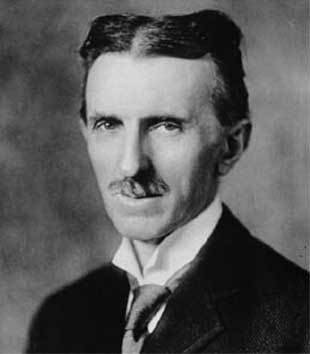
When you look at Tesla’s accomplishments, you realize that, in terms of innovation, Tesla outshines them all: he is the father of wireless communication, alternating current, radar and solar technology.
At exactly midnight, between July 9 and 10, 1856, Nikola Tesla was born in the Croatian village of Smiljan. Traditionally, most men born in this region were destined for a life as a minister in the Church or as an officer in the Austro-Hungarian Army. But young Tesla had other plans.
The beginning of his life was defined by three things: an illness, a family tragedy and the unique genetic gifts he inherited from his mother.
Tesla always claimed that his photographic memory and vivid imagination were passed down from his mother, Ðuka Mandíc. She could recite by heart long passages of poetry without hesitation and handcrafted her own tools to create fabrics with impressively intricate designs.
And when Nikola was just five years old, his 12-year-old brother Daniel died in a mysterious accident. The event deeply affected young Nikola and he tried to console his parents the only way he knew how: by becoming the best student he could be. By the age of eight, he was reading constantly and starting to grow interested in engineering and physics.
Tesla was an excellent student, even though he could get on some of his teachers’ nerves. In 1875, at the Austrian Polytechnic School, he was at odds with one of his professors.
In this particular professor’s class, Tesla openly criticized the direct current motors being used around the world. He knew a better motor could be created to produce higher voltages and send them greater distances. Despite the professor’s doubts, the ambitious Tesla tasked himself with finding a solution, but it would be many years before he arrived at one.
But by the end of 1879, Tesla was brike and had to drop out of school. His father had just passed away and he was forced to find work to support himself.
While walking through a park one day, a vision for a new and improved motor came to him. The induction motor! Rather than the single circuit, direct current motor, this motor would use two or more alternating currents to create a rotating magnetic field to generate electricity.
He quickly realized that this motor could create a revolutionary new way to power the world: a polyphase system capable of generating and distributing much greater power. He just had to find the means to actualize it.
When Tesla arrived in America in 1884, he immediately set out into the streets of New York City, ready to make a name for himself. And it didn’t take him long to show up at the offices of the Edison Electric Company.
Thomas Edison’s company was responsible for powering most of New York City. But his glitchy and unstable direct current (DC) generators were far from perfect and Tesla knew it.
Edison offered Tesla a deal: If he could improve the design of his generators, there would be $50,000 in it for him.
To Tesla it sounded like a good proposition. And, over time, he redesigned and improved 24 of Edison’s electrical generators, even to the point of installing automatic controls.
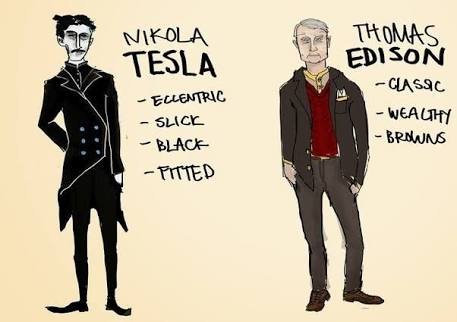
But, when it came time for Tesla to collect his money, Edison looked confused and told him, “Tesla, you don’t understand our American humor.” Edison instead offered to increase his pay from $18 to $28 a week. Tesla felt cheated and promptly resigned, discouraged and depressed about his chances in this new country.
By 1888, Tesla had received his first patent for his AC induction motor and, by 1891, he had a total of 40 patents related to it. His polyphase system was beginning to come to life.
This activity caught the attention of George Westinghouse, a powerful businessman looking to compete with Edison.
Westinghouse saw the brilliance in Tesla’s new technology. With its use of electromagnetic induction, Tesla’s AC motors did away with the grinding parts that would spark and wear down in Edison’s DC motors
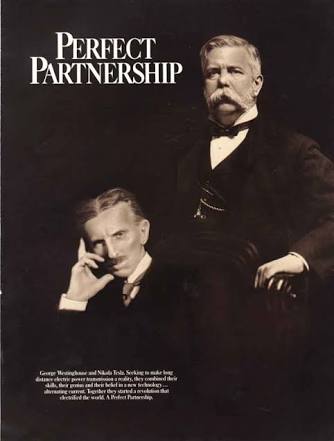
Westinghouse underbid Edison’s General Electric to secure the rights to power the 1893 World’s Fair in Chicago. It served as a massive display of the effectiveness and reliability of AC electricity distribution.
It also proved that, despite Edison’s claims, AC power wasn’t uncontrollably dangerous.
Twenty-five million people visited the Fair and Tesla put on his own sideshow. He wowed audiences by controlling high-frequency volts of electricity and wirelessly lighting up tubes as he safely sent currents through his own body.
Throughout the 1890s, Tesla would give such jaw-dropping presentations around the world.
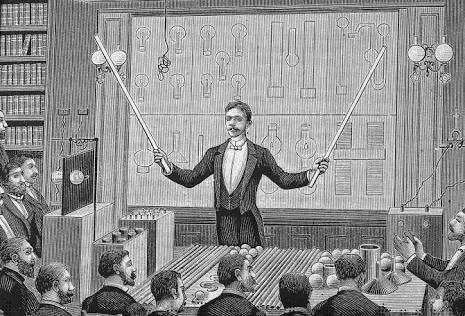
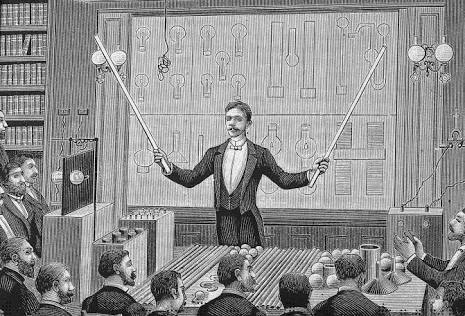
With the success of the 1893 World’s Fair behind him, the future was looking bright for Nikola Tesla. And if there were any lingering doubts about the winner of the War of the Currents, Westinghouse and Tesla were about to put them to rest.
His dream became a reality when he received word from George Westinghouse that he’d secured the contract to build the first electrical generators at Niagara Falls. Tesla oversaw the installation and, by 1896, the first powerhouse was up and running, sending 15,000 horsepower of electricity 26 miles to the neighboring city of Buffalo.
Tesla and his revolutionary polyphase system were now the talk of the town.
The New York Times declared Tesla’s “undisputed honor” in harnessing Niagara’s power. The American Institute of Electrical Engineers awarded him a medal of honor.
Even other nations were taking notice. Both the Prince of Montenegro and England’s Lord Kelvin bestowed their praises on Tesla. 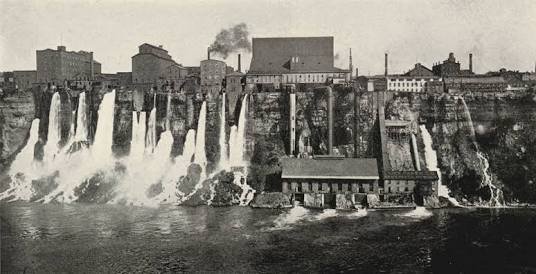
during the War of the Currents against Edison, Tesla kept himself busy at the lab. Many of his experiments during this time were focused on his dream of distributing electricity wirelessly around the world. Tesla believed that either the Earth itself, or the electrically charged upper stratosphere of the Earth, could be used as a conductor.
These ideas guided Tesla’s groundbreaking progress on radio and remote control technology.
In 1893, at the National Electric Light Association in St. Louis, he gave the very first public demonstration of radio communication. Using a five-kilowatt spark transmitter he sent a wireless message to a receiver 30 feet away.
At the time Tesla also loved to entertain guests at his laboratory by putting on dazzling displays.
Mark Twain was an admiring friend who would often visit Tesla’s lab when he was in New York. In fact, a lab experiment involving a photograph Tesla took of Mark Twain was later revealed to be the first X-ray photograph taken in the United States.
Despite his infinitely curious mind, Tesla was obsessed with a single idea for most of his adult life: being able to power the world with wireless electricity.
His laboratory experiments in this field were becoming too dangerous for a crowded city but, luckily, in 1899, an associate found an isolated location in Colorado Springs. Tesla jumped at the chance to conduct some large-scale experiments.
Upon arriving in Colorado, Tesla immediately built what he called a magnifying transmitter – essentially a huge Tesla coil that could generate high electric voltage. Activating it sent huge bolts of lightning up into the Colorado Springs sky, testing the possibilities of sending electricity wirelessly through the atmosphere.

He tested the possibility of sending electricity through the Earth’s surface as well.
By experimenting with frequencies both high and low he sent massive amounts of voltage into the surrounding area. He sent electrical shocks through the earth that would scare local horses and wirelessly activate light bulbs in the ground at distances of as much as 26 miles away.
These experiments famously resulted in the July 3, 1899 blackout of the entire town of Colorado Springs when his transmitter overloaded the town’s own generator.
For Tesla, the experiments were a success. The results made him believe that he could build a facility that would change the world.
When Tesla returned to New York in January of 1900, he proposed building a towering facility called Wardenclyffe. He was convinced it would allow multiple lines of wireless communication and electrical power to be sent around the world.
But again, funding proved difficult to find.
Westinghouse declined and all Tesla was able to put together was $150,000 from financier J. Pierpont Morgan. This was enough to build the structure and hire a staff but not enough to get it into operation.
Tesla would spend the better part of the next 17 years trying, but failing, to get Wardenclyffe up and running. His dream of wireless electricity would remain out of reach.
Tesla’s life was often filled with controversy. But few issues lasted as long as the debate over who would be credited with inventing radio communication.
The fact of the matter is that Tesla filed his fundamental radio patent in 1897. But when Guglielmo Marconi sent the first transatlantic radio communication in December of 1901 it set off a series of legal battles that would last decades.
After this transatlantic signal was sent, Tesla responded by saying, “Marconi is a good fellow. Let him continue. He is using 17 of my patents.”
What ended up hurting Tesla was that, during the legal battles that lasted 40 years, Marconi reaped plenty of financial gains while Tesla struggled to make ends meet.
It wasn’t until 1943, eight months after Tesla’s death, that the US Supreme Court finally ruled that Tesla’s fundamental radio patent was to be upheld.
But even during these hardships he remained a visionary: in a 1917 article published in The Electrical Experimenter, Tesla accurately described modern radar technology. His description of a stream of electric charges bouncing off of objects to reveal their locations was the primary inspiration to Dr. Emil Girardeau, whose team built and installed radar stations in France in 1934.
At his 75th birthday party in 1931, Tesla was honored by many peers including Nobel laureates and Albert Einstein. When interviewed at the party, Tesla explained he was working on two things: disproving Einstein’s Theory of Relativity and a creating new source of energy that had nothing to do with “so-called atomic energy.”
When Tesla died alone in his hotel room at the age of 86 on January 7, 1943, he left behind some unanswered questions.
Despite the fact that Tesla had been an American citizen since 1891, his papers and belongings were confiscated by the government’s Office of Alien Property Custodian. It was rumored this may have been due to Tesla talking about his work on a powerful, weaponized particle beam technology that he offered as another solution to end war.
No papers on the details of any such beam were ever found. As with most of Tesla’s inventions, the design most likely lived completely in his imagination.
Nikola Tesla was perhaps the greatest inventive mind America has ever known. Certainly, when it comes to the field of electricity, few have surpassed his boundless imagination
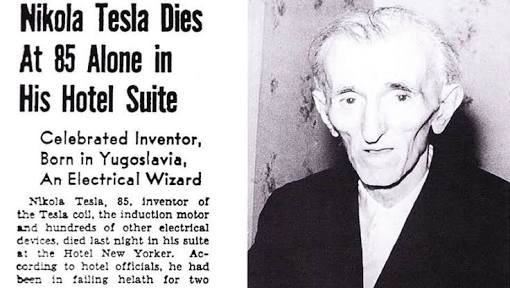
This post has received a 1.25 % upvote from @drotto thanks to: @quantum999.
Downvoting a post can decrease pending rewards and make it less visible. Common reasons:
Submit
Someone who is definitely worth to write about and be honored and remembered.
Thx for your article.
Downvoting a post can decrease pending rewards and make it less visible. Common reasons:
Submit
Yes I think he was one of the best scientist of his era
Downvoting a post can decrease pending rewards and make it less visible. Common reasons:
Submit
And thank you for your upvote
Downvoting a post can decrease pending rewards and make it less visible. Common reasons:
Submit
It was a pleasure
Downvoting a post can decrease pending rewards and make it less visible. Common reasons:
Submit